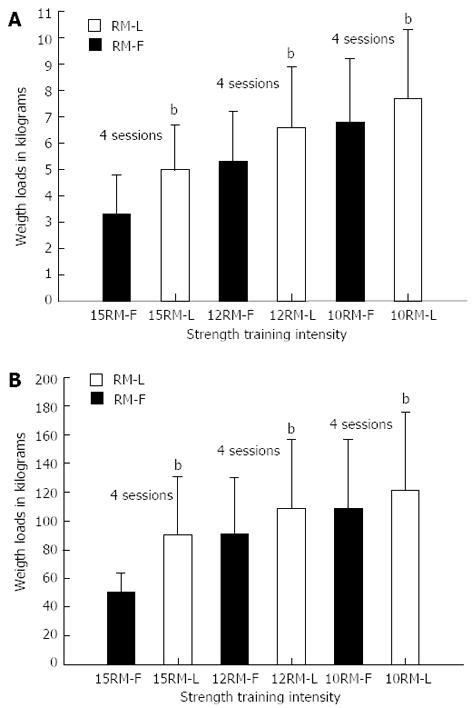Copyright
©2013 Baishideng Publishing Group Co.
World J Orthop. Oct 18, 2013; 4(4): 248-258
Published online Oct 18, 2013. doi: 10.5312/wjo.v4.i4.248
Published online Oct 18, 2013. doi: 10.5312/wjo.v4.i4.248
Figure 1 The progressive strength training included unilateral (fractured limb) knee-extension (A) and bilateral leg presses (B).
Figure 2 Feasibility of the programme.
A: Absolute weight load over 12 fractured knee-extension strength-training sessions; B: Absolute weight load over 12 bilateral leg press strength-training sessions. bP < 0.001 vs RM-F. RM: Repetition maximum; F: First session; L: Last session.
Figure 3 Hip pain.
A: Hip pain over 12 fractured knee-extension strength-training sessions; B: Hip pain over 12 bilateral leg press sessions; C: Hip pain at rest and at the time of baseline functional testing or at the first strength-training session; D: Hip pain at rest and at the last testing or training session. RM: Repetition maximum; F: First session; L: Last session.
Figure 4 Follow up.
A: Improvements in function and knee-extension strength after 6 wk of training, bP < 0.001 vs Intention to treat analysis (n = 39); B: Correlations between knee-extension strength and function after 6 wk of training, aP < 0.05 vs Knee-extension strength, non-fractured. FKES: Fractured knee extension strength; NFKES: Non-fractured knee extension strength; 10mWT: 10-m walk test; 6MWT: 6-min walk test; SF-36P: Short form-36 physical; NMS: New mobility score.
- Citation: Overgaard J, Kristensen MT. Feasibility of progressive strength training shortly after hip fracture surgery. World J Orthop 2013; 4(4): 248-258
- URL: https://www.wjgnet.com/2218-5836/full/v4/i4/248.htm
- DOI: https://dx.doi.org/10.5312/wjo.v4.i4.248












